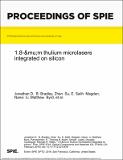1.8-μm thulium microlasers integrated on silicon
Author(s)
Adam, Thomas N.; Leake, Gerald; Coolbaugh, Douglas; Bradley, Jonathan; Su, Zhan; Magden, Emir Salih; Li, Nanxi; Byrd, Matthew James; Purnawirman, Purnawirman; Watts, Michael; ... Show more Show less
Download97440U.pdf (632.8Kb)
PUBLISHER_POLICY
Publisher Policy
Article is made available in accordance with the publisher's policy and may be subject to US copyright law. Please refer to the publisher's site for terms of use.
Terms of use
Metadata
Show full item recordAbstract
A key challenge for silicon photonic systems is the development of compact on-chip light sources. Thulium-doped fiber and waveguide lasers have recently generated interest for their highly efficient emission around 1.8 μm, a wavelength range also of growing interest to silicon-chip based systems. Here, we report on highly compact and low-threshold thulium-doped microcavity lasers integrated with silicon-compatible silicon nitride bus waveguides. The 200-μmdiameter thulium microlasers are enabled by a novel high quality-factor (Q-factor) design, which includes two silicon nitride layers and a silicon dioxide trench filled with thulium-doped aluminum oxide. Similar, passive (undoped) microcavity structures exhibit Q-factors as high as 5.7 × 10[superscript 5] at 1550 nm. We show lasing around 1.8-1.9 μm in aluminum oxide microcavities doped with 2.5 × 10[superscript 20] cm [superscript -3] thulium concentration and under resonant pumping around 1.6 μm. At optimized microcavity-waveguide gap, we observe laser thresholds as low as 773 μW and slope efficiencies as high as 23.5%. The entire fabrication process, including back-end deposition of the gain medium, is silicon-compatible and allows for co-integration with other silicon-based photonic devices for applications such as communications and sensing.
Date issued
2016-02Department
Massachusetts Institute of Technology. Department of Electrical Engineering and Computer Science; Massachusetts Institute of Technology. Research Laboratory of ElectronicsJournal
Proceedings Volume 9744, Optical Components and Materials XIII
Publisher
SPIE
Citation
Bradley, Jonathan D. B., et al. "1.8-Μm Thulium Microlasers Integrated on Silicon." Proceedings Volume 9744, Optical Components and Materials XIII, 13-18 February, 2016, San Francisco, California, edited by Shibin Jiang and Michel J. F. Digonnet, SPIE, 2016, p. 97440U. © 2016 SPIE
Version: Final published version